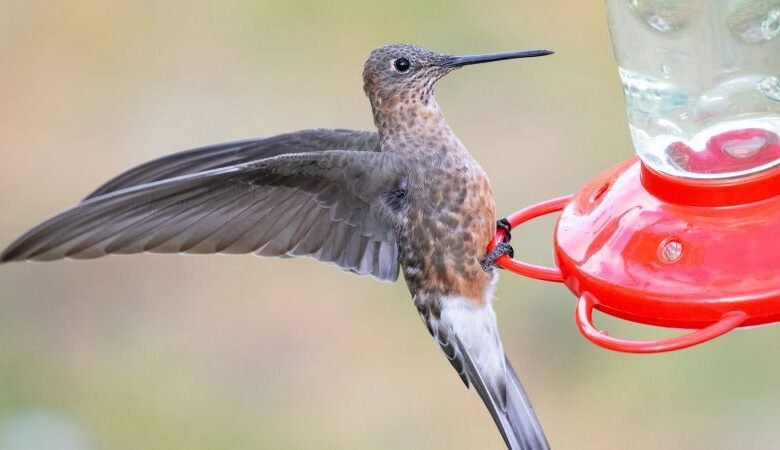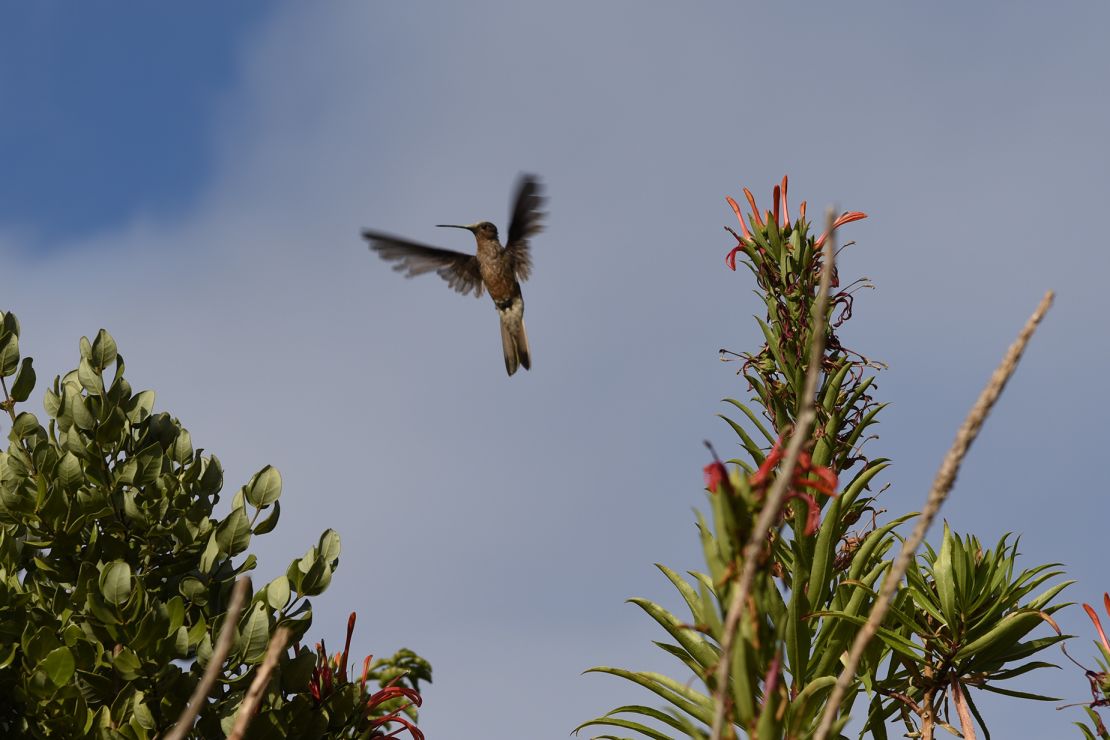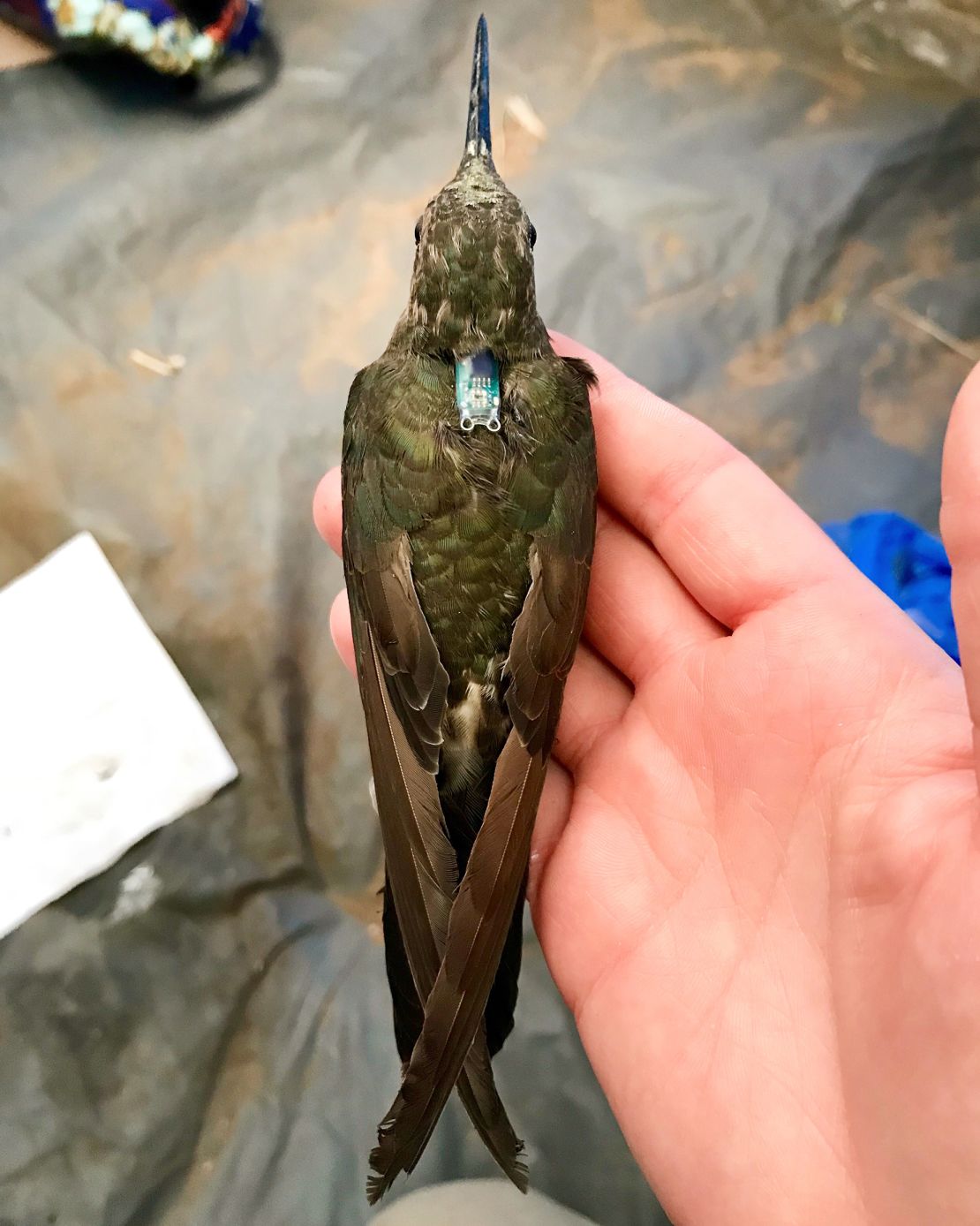Small backpacks reveal new species of the world’s largest hummingbird

Sign up for CNN’s Wonder Theory science newsletter. Explore the universe with news about fascinating discoveries, scientific breakthroughs and more.
CNN
–
The world’s largest hummingbird has been hiding in plain sight for centuries – and scientists only discovered the species is distinct from another giant species after attaching small backpacks to hummingbirds to understand their migration patterns.
Along the way, researchers also identified the hummingbird’s longest migration journey, which encompasses a round trip of 8,368 kilometers, or roughly the distance between New York City and Buenos Aires.
Questions surrounding South America’s giant hummingbird have persisted since naturalist Charles Darwin first observed them in 1834, during his expedition aboard HMS Beagle.
Darwin observed the birds, which are about eight times the size of typical hummingbirds, breeding along the Pacific coast of Chile, but then seemed to disappear completely after breeding. He speculated that giant hummingbirds migrated to the Atacama Desert region, located in northern Chile.
Now, new research has revealed that two distinct species of giant hummingbird exist in South America – the northern giant hummingbird, which lives year-round in the Andes, and the migratory southern giant hummingbird – and have evolved separately for millions of years. .

A new study describing the birds appeared Monday in the journal Proceedings of the National Academy of Sciences.
“There are not many animal migrations of large, charismatic species that are still completely unknown, but this was the case for southern giant hummingbirds,” said study lead author Jessie Williamson, a National Science Foundation postdoctoral fellow and Rose Postdoctoral Fellow at Cornell. Laboratory of Ornithology in Ithaca, New York. “We wanted to finally solve this mystery.”
Giant hummingbirds differ from hundreds of other hummingbird species in many other ways.
“Everything about the giants is anomalous – not only are they much larger (twice or more) than the next largest hummingbird – but their wingbeats and heartbeats are much slower,” Williamson said. “And their wings are proportionally longer, so they have a completely unique appearance in flight – almost like a floating swift.”
Swifts are medium-sized and fast birds, included in the Apodidae family, which also includes hummingbirds.
But studying hummingbirds, regardless of their size, is an arduous task. The team worked with local landowners and village residents in Peru and Chile during fieldwork.
“Capturing giant hummingbirds is very challenging,” study co-author Emil Bautista, a researcher at the Center for Ornithology and Biodiversity in Lima, said in a statement. “They watch everything and know their territories well. We had to be strategic in choosing locations for our networks. If giant hummingbirds see something unusual, they will not visit that location. They are more observant than other birds.”
The research team spent nine months camping in rural areas of Chile and Peru, working from sea level to the steep, cactus-filled slopes of the Andes and spending weeks without electricity or running water, Williamson said.
Williamson designed a backpack harness, using a type of jewelry cord to attach a microtracking device to 57 hummingbirds in Chile.
“Designing backpack harnesses suitable for giant hummingbirds required two field seasons of trial and error, including practicing the harness design on a stuffed hummingbird finger puppet… with a paper mache mock-up geolocator device, as well as lots of consultation with colleagues who have experience tracking small migratory birds,” said Williamson.

The geolocator backpacks weighed 0.3 grams and were designed to be small and light enough not to interfere with the birds’ flying style.
Williamson published a paper describing his project and how to safely attach it to hummingbirds in the Journal of Avian Biology in June 2021.
“It is difficult to work with hummingbirds because they are light, with long wings and short legs. They are nature’s little acrobats,” she said.
But it wasn’t enough to catch the birds, strap on their backpacks and release them — the birds had to be recaptured for the team to collect data.
The researchers were able to recover data from eight of the geolocators by recapturing the birds using fine-mesh nets called “mist nets,” commonly used by ornithologists, Williamson said.
What the team discovered was that southern migratory giant hummingbirds are like human mountaineers.
Geolocator data revealed that migratory giant hummingbirds can ascend from sea level to more than 13,000 feet (3,962 meters) in elevation, and their journeys have taken them as far north as the Peruvian Andes.
But birds don’t fly directly to these high altitudes. Instead, like mountaineers, they take a break during the climb for several days to allow their blood and lungs to acclimate to the lower oxygen levels.
By tracking the birds’ migration with geolocators and satellite transmitters, scientists have discovered what they believe to be the longest known hummingbird migration, spanning 8,368 kilometers from the Chilean coast to the Andes in Peru and back.
As researchers studied the birds and compared them with genetic data from museum specimens, they realized there were two types of giant hummingbirds.
“No one had figured out where migratory giant hummingbirds go because they were hidden among non-migratory giant hummingbirds,” said study lead author Christopher Witt, professor of biology and director of the University of New Mexico’s Museum of Southwestern Biology. in a study. declaration. “The two forms of giant hummingbird look almost identical – for centuries, ornithologists and birdwatchers never noticed they were different. We couldn’t have discovered this without miniaturized trackers.”
A change in migratory behavior likely drove the difference between the two species. By studying museum species, including a 154-year-old specimen, researchers realized that the two types of giant hummingbirds evolved separately for about 3 million years.
“They are as different from each other as chimpanzees are from bonobos,” Witt said. “The two species overlap in their wintering ranges at high altitudes. It is surprising that until now no one has discovered the mystery of the giant hummingbird, but these two species have been separated for millions of years.”
The northern giant hummingbird, which lives in the high Andes year-round, has different lung and blood capacity compared to the southern giant hummingbird.
After realizing that the two birds were entirely different species, the study team named the giant northern hummingbird Patagona chaski, an homage to chaskis, the Quecha word for messengers, from the Inca Empire. Quecha is a group of indigenous languages used in Peru and neighboring countries.
“Chaski runners were confident sprinters, capable of speed and endurance on steep slopes, in part due to high-capacity lungs and rigorous aerobic training at high altitudes,” the authors wrote in the study.
Researchers report that both populations of giant hummingbirds are stable, and some can even be seen enjoying nectar from backyard feeders.

Now that the two distinct species have been confirmed, the team wants to better understand how the populations interact, especially when they live in the same parts of the Andes during the winter.
“We have to figure out where these two forms come together and how they interact,” Witt said. “Do they compete, is one dominant over the other, how can they divide resources, and do they mix or spatially segregate within the winter range? Lots of interesting questions to pursue!”
Williamson also wants to work with botanists to understand how bird migration patterns may have evolved alongside the flowering plants that birds use to sustain themselves on their travels.
“I’m really interested in how southern giant hummingbirds make such dramatic changes in elevation during migration,” Williamson said. “They are like miniature climbers. How do they change their physiology to facilitate these movements?”




